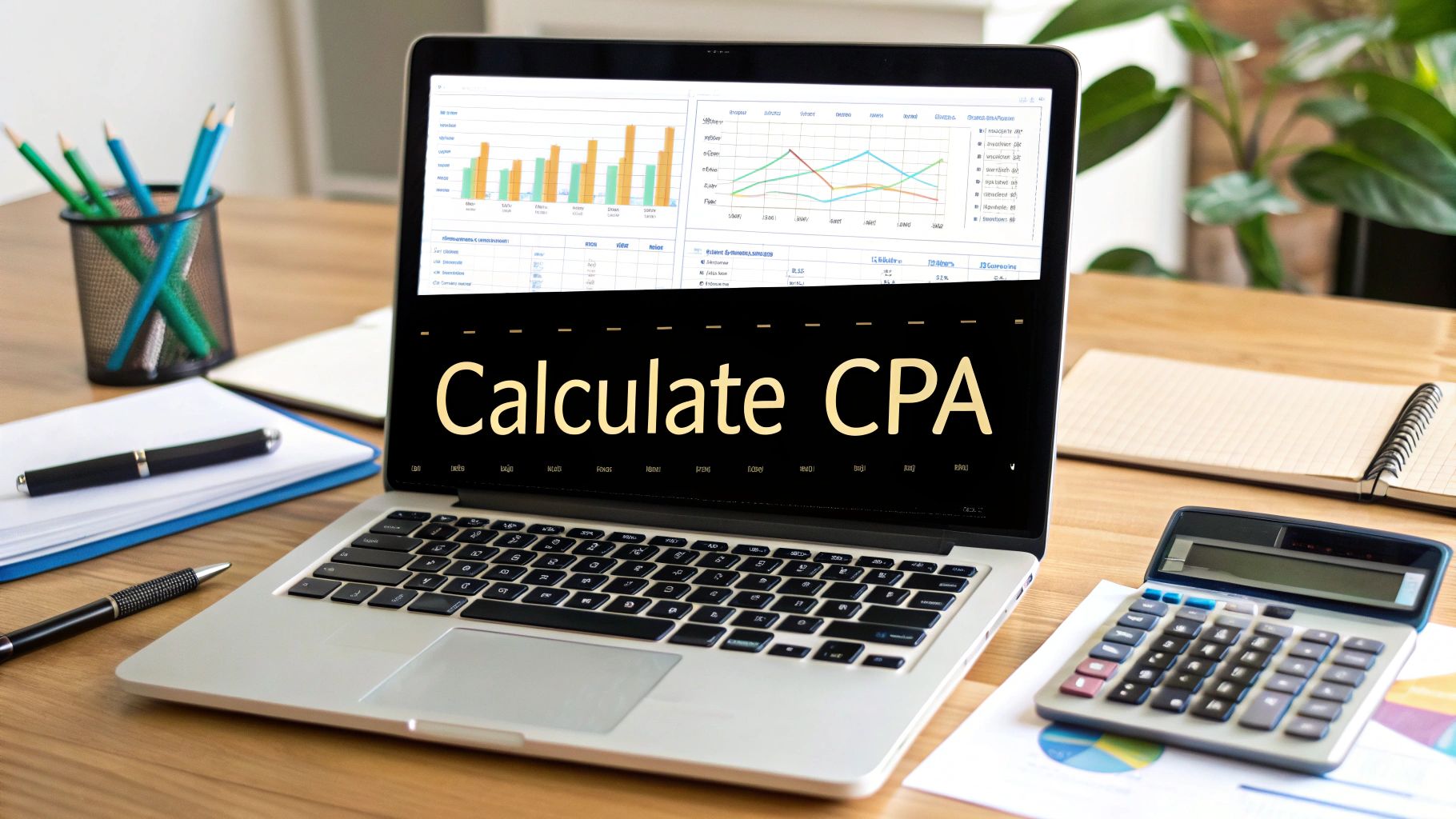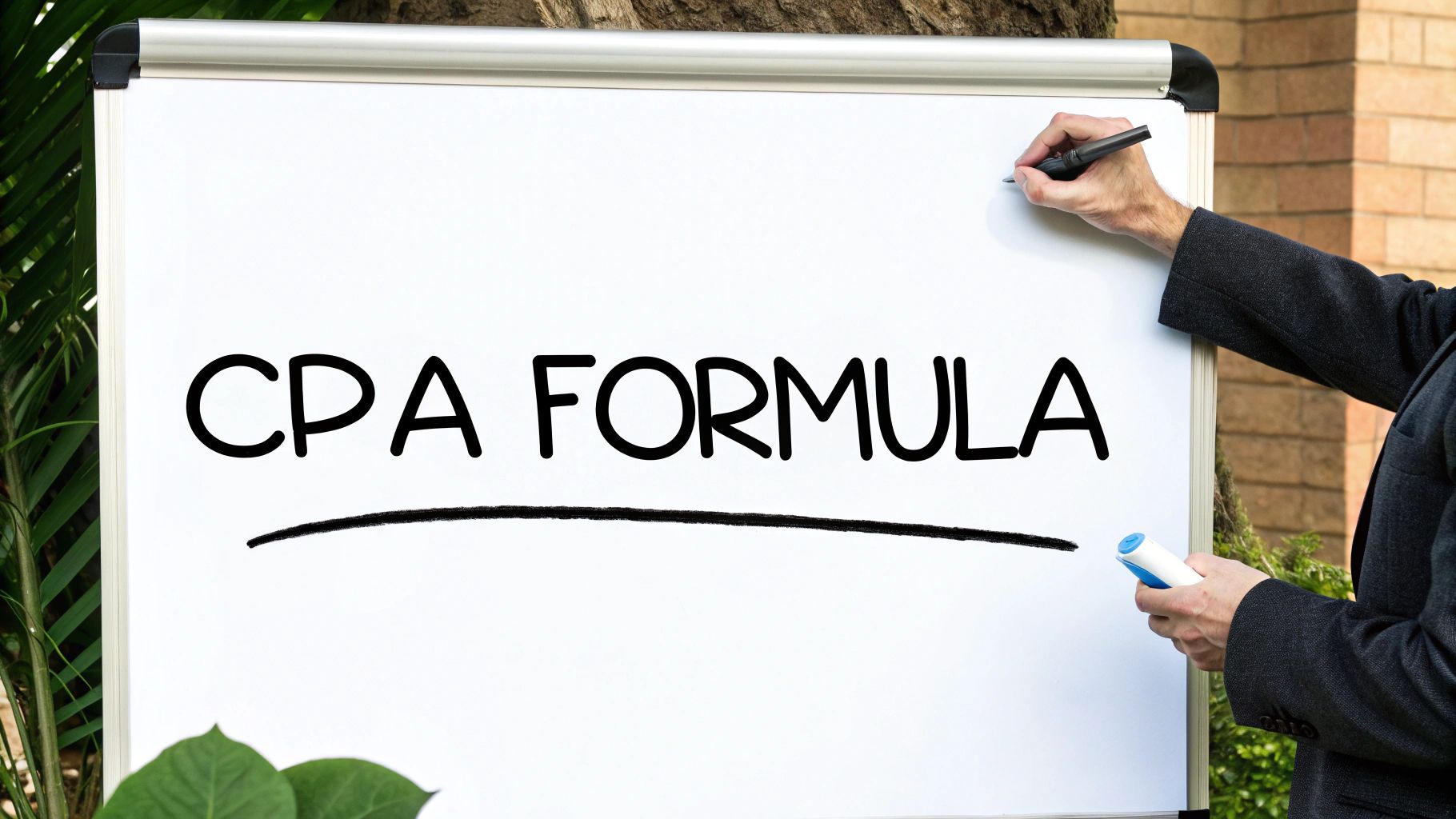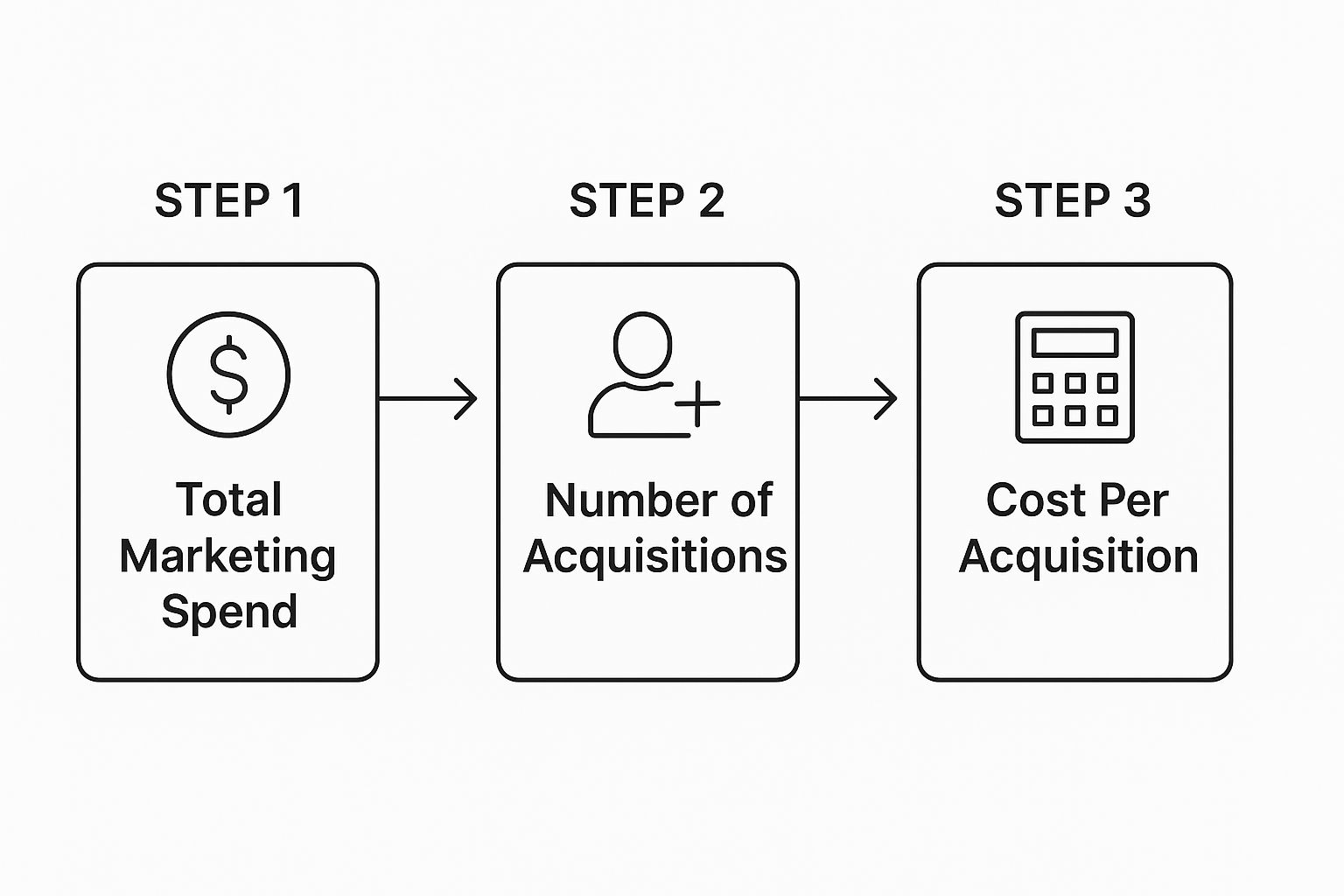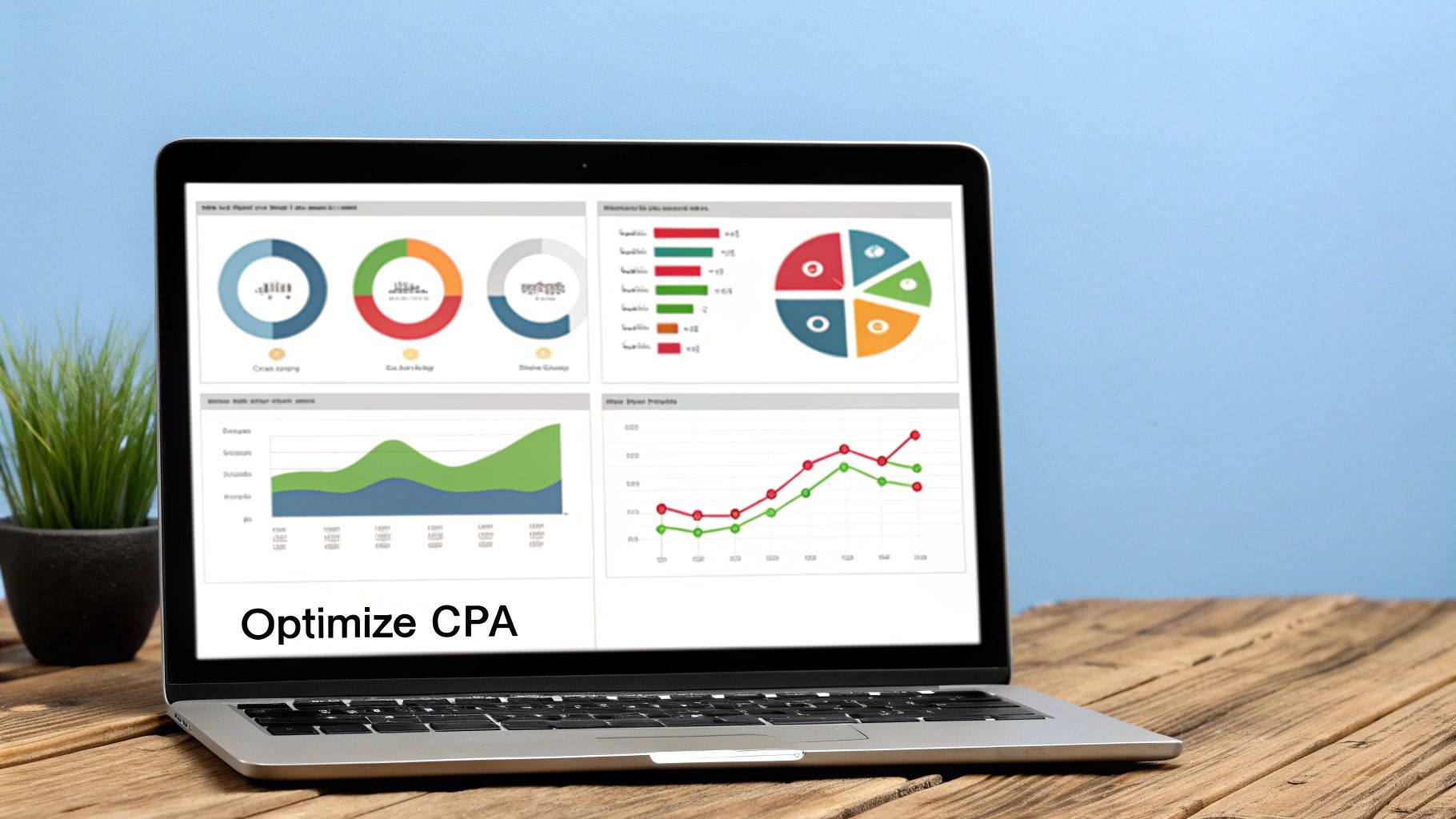August 19, 2025
How to Calculate Cost Per Acquisition


Alright, let's break down how to figure out your Cost Per Acquisition. At its heart, the calculation is pretty simple. You just take the total amount you spent on a marketing campaign and divide it by the number of new customers you actually got from it.
The formula looks like this: Total Cost / Total New Customers. That’s it. This number tells you the real-world price tag for each and every customer you win.
Why CPA Is Your Most Important Marketing Metric
Before you even think about opening a spreadsheet, let's get one thing straight. Your Cost Per Acquisition (CPA) isn't just another vanity metric to add to your dashboard—it’s the financial pulse of your entire marketing operation. It tells you the unvarnished truth about how your strategy is performing.
When you really get a handle on your CPA, you stop throwing money at ads and just hoping for the best. You start making smart, data-backed decisions about your budget. It’s the key difference between gambling with your marketing dollars and truly investing them.
This one metric helps you see with crystal clarity which channels are actually making you money and which ones are just quietly draining your bank account.
Tying CPA Back to Your Business Goals
Think of CPA as a non-negotiable KPI for building a business that lasts. It’s absolutely vital for effective client acquisition because it gives you the hard data you need to grow sustainably.
Once you know exactly what it costs to land a customer, you can:
- Set realistic budgets: You can confidently pour money into the channels you know deliver the best results.
- Fix what’s broken: Easily spot underperforming ads and campaigns that need a tune-up or to be cut altogether.
- Forecast with confidence: Predict how many customers you can realistically acquire with a set budget.
This metric is more important than ever, especially when you look at how much more expensive it's getting to attract new customers.
The cost of getting a new customer is skyrocketing. Between 2013 and 2021, the average customer acquisition cost shot up by an insane 222%. That means companies went from losing an average of $9 per new customer to $29, all because of inefficient marketing spend.
So, obsessing over your CPA isn't about being cheap. It’s about being smart. It’s about building a profitable, scalable business where marketing isn't just a cost center—it's your most powerful engine for growth.
The Simple Formula for Calculating CPA
Alright, let's break down how you actually figure out your Cost Per Acquisition. It all comes down to a surprisingly simple formula, but the real magic is in knowing exactly what numbers to plug into it.
At its core, here’s what you're working with:
Cost Per Acquisition (CPA) = Total Marketing Costs / Number of New Customers Acquired
This little equation tells you, on average, how much you’re spending to bring one new paying customer through the door. But to get a number you can actually trust and make decisions with, we need to get specific about what "total costs" and "new customers" really mean.
What Goes into Your Total Marketing Costs?
This is the first place people often go wrong. "Total Marketing Costs" isn't just your ad spend. Not even close. To get a true CPA, you have to account for every single dollar that went into your customer acquisition efforts.
Think bigger. Your total cost is the entire budget for your marketing machine. That means you need to include:
- Direct Ad Spend: This is the obvious one—the cash you hand over to platforms like Google Ads or Meta.
- Tool Subscriptions: What are you paying for SEO tools, marketing automation software, or analytics platforms? That all goes in the pot.
- Creative & Content Costs: Did you hire a freelance designer for those ad graphics? A writer for that landing page copy? Add it to the list.
- Team Salaries: This one’s tricky, but you should factor in a portion of the salaries for anyone directly working on acquisition campaigns.
If you skip these "hidden" costs, you’ll end up with a CPA that looks amazing on paper but is completely misleading. Be a detective here—track down every expense.
Breaking Down the CPA Formula Components
Here’s a clear look at the variables you need for an accurate Cost Per Acquisition calculation, including real-world examples for each.
Getting these components right is the difference between a vanity metric and a real business KPI.
What Exactly Is a "New Customer"?
Now for the other side of the formula: "Number of New Customers Acquired." This sounds simple, but an "acquisition" can mean different things to different businesses. The key is consistency.
For instance, an acquisition could be:
- For a SaaS business: A user who converts from a free trial to a paid plan.
- For an e-commerce store: A shopper who makes their very first purchase.
- For a service business: A new client who signs a contract or pays for their first project.
You have to define what that final conversion point is—the moment someone officially becomes a paying customer.
Ultimately, CPA is your go-to metric for judging how efficiently your campaigns are running and where your budget is best spent. It’s all about dividing the total cost of your efforts by the number of customers you won in that time. You can always master the essentials of the cost per acquisition formula on spideraf.com if you want to dig even deeper.
Finding the Right Data for Your Calculation

Your Cost Per Acquisition calculation is only as good as the data you feed it. Seriously. Think of it like baking a cake—if you use salt instead of sugar, the result will be a mess, no matter how perfectly you follow the recipe. To get a truly accurate CPA, you have to put on your data detective hat.
The first place everyone looks is their ad platforms, and for good reason. Pulling your total ad spend from Google Ads or Meta for a specific time frame is pretty simple. This number is the foundation of your "Total Costs," but it's really just the tip of the iceberg.
So many marketers stop right there, and that's a massive mistake. To get the real picture, you need to dig deeper and uncover the "hidden" costs that often get overlooked but are absolutely critical for an accurate calculation.
Accounting for All Acquisition Expenses
To get a true sense of your spend, you need to think way beyond the ad budget itself. Your total marketing cost has to include every single expense that contributes to winning a new customer.
This means you need to start gathering data on things like:
- Software and Tools: Think about all those monthly subscriptions. Your marketing automation platform, landing page builder, analytics software, and any other tool you rely on to run campaigns all have a cost.
- Creative and Content: Did you hire a freelancer to design ad creative? Pay a copywriter for that killer headline? Those one-off project fees need to be factored into the total cost for the period they were used.
- Team Costs: This one can be tricky, but it's important. You need to allocate a portion of the salaries for the people on your team who directly work on customer acquisition. A practical way to do this is to estimate the percentage of their time they spend on these campaigns and apply that to their salary for the period you're measuring.
The real goal here is to create a single source of truth for all your expenses. Honestly, a simple spreadsheet is your best friend. Set up columns for each cost category and get into the habit of logging every expense for the month or quarter you're analyzing.
This kind of organized tracking prevents you from forgetting important details down the line. For example, once you're precisely tracking your spend, you can start making smarter strategic decisions. If you're looking to get more out of your ad platform data, diving into the specifics of https://www.keywordme.io/blog/google-ads-audience-targeting is a great place to start. A detailed expense sheet makes it crystal clear if your efforts to reach a more targeted—and potentially more expensive—audience are actually paying off with a better CPA in the end.
Let's Calculate CPA with a Real-World Example
Alright, enough with the theory. Let's get our hands dirty and see how this actually works.
Imagine you're running a small e-commerce shop that sells custom coffee mugs. You've been spending money on marketing for the past month, but you need to know if it's actually paying off. This is where calculating your Cost Per Acquisition comes in.
First, Tally Up Your Total Marketing Spend
The first thing we need to do is round up every single dollar you spent on marketing. And I mean everything. It’s easy to just look at your ad spend, but that doesn't paint the full picture.
Let's say your costs for the month looked something like this:
- Google Ads Spend: You put $2,500 into your main search campaigns.
- Social Media Ads: Your campaigns on Meta cost you $1,500.
- Influencer Fee: You paid a micro-influencer $500 for a sponsored post.
- Marketing Tools: Don't forget the small stuff! Your email and analytics software subscriptions came to $150.
Add all that up, and you get a Total Marketing Spend of $4,650 for the month. That’s the first piece of our puzzle.
Now for the second piece: how many new customers did all that effort bring in? You dive into your analytics and find you got 150 brand-new, first-time buyers during that same period.
With those two numbers locked in, the math is refreshingly simple.
$4,650 (Total Costs) / 150 (New Customers) = $31 CPA
So, on average, it cost you $31 to win over each new customer last month. That's a great starting point, but the real magic happens when you start segmenting this data.
Digging Deeper: Breaking Down CPA by Channel
An overall CPA gives you a bird's-eye view, but the actionable insights come from zooming in on individual channels. This is where you can really start making smarter decisions with your budget.
Let's take a closer look at your Google Ads performance, for example.

Let's imagine your analytics show that the $2,500 you spent on Google Ads was directly responsible for bringing in 100 of your new customers. The calculation for that channel is:
- Google Ads CPA: $2,500 / 100 = $25
Now, let's do the same for social media. That channel spent $1,500 and brought in 40 new customers.
- Social Media CPA: $1,500 / 40 = $37.50
And just like that, you have a crystal-clear insight. Google Ads is the star performer here, acquiring customers for $12.50 less than your social media efforts. This is exactly the kind of data-driven insight you need for effective ppc campaign optimization.
Armed with this information, you can now confidently decide to reallocate some of that social media budget over to Google Ads, which should help lower your overall CPA and get you more bang for your buck.
How to Know if Your CPA Is Any Good

Alright, you’ve crunched the numbers and you have your Cost Per Acquisition. Now you’re staring at that single figure, wondering… is this good? Bad? Just… okay?
Let’s get one thing straight: there's no universal "good" CPA. A $50 CPA would be a total nightmare if you're selling $25 t-shirts. But for a SaaS company with a high-ticket subscription? A $50 CPA would be an absolute steal.
The only way to truly judge your CPA is to stop looking at vague industry benchmarks and start looking inward at your own numbers—specifically, your profit margins and Customer Lifetime Value (LTV).
The Golden Rule CPA vs LTV
This is where the magic happens. Your CPA doesn't live in a vacuum; it’s part of a relationship, and its partner is LTV. To figure out if your acquisition costs are actually working for you, you first need to know how to calculate customer lifetime value.
The rule of thumb is beautifully simple: as long as your LTV is significantly higher than your CPA, you’re on the right track to building a profitable, sustainable business.
A healthy LTV:CPA ratio is often cited as 3:1. That means for every dollar you spend bringing a customer in the door, you make three dollars back over their lifetime with you. A 1:1 ratio? You're essentially running on a treadmill, breaking even on every new sale. Anything less, and you're actively losing money.
This is why getting your tracking right from the very beginning is so critical. Solid Google Ads conversion tracking isn't just a nice-to-have; it's the foundation for making these crucial calculations.
Finding Your Industry's Starting Point
While LTV is your north star, it can be useful to see where you stand within your industry. Just keep in mind that acquisition costs swing wildly from one sector to another based on things like sales cycle length, average deal size, and the go-to marketing channels.
For example, recent data shows fintech businesses have a sky-high average CPA of around $1,450. Meanwhile, some eCommerce SaaS companies can acquire customers for as little as $274. Checking out industry averages gives you a decent, if imperfect, starting point.
Got Questions About CPA? We’ve Got Answers.
Once you start digging into your Cost Per Acquisition, you’ll naturally run into a few tricky questions. It's one thing to know the formula, but using it effectively in the wild is a whole different ball game.
Let's clear up some of the most common sticking points so you can use this metric with confidence.
How Often Should I Calculate My CPA?
There's no single magic number here, but establishing a good rhythm is everything.
For a big-picture health check of your business, calculating your overall CPA on a monthly basis is a great starting point. This gives you a steady pulse on how efficiently your marketing engine is running and helps you catch trends before they become problems.
But don’t just leave it at that. You should also get into the habit of calculating CPA on a per-campaign basis. The moment a campaign wraps up, run the numbers. This gives you immediate feedback on what worked (and what flopped), letting you pivot and make smarter decisions for your next push.
What Is the Difference Between CPA and CAC?
Ah, the classic mix-up. People throw these terms around interchangeably all the time, but there’s a small but mighty difference you need to know.
CPA (Cost Per Acquisition) is broad. It can measure the cost of getting anything valuable—a lead, a newsletter signup, an e-book download, you name it. CAC (Customer Acquisition Cost) is super specific: it’s the cost to land a new paying customer.
While this guide has mostly focused on acquiring customers (which leans heavily toward CAC), understanding this distinction helps you speak the same language as your team and analyze your marketing funnel with a much sharper eye.
My CPA Is Too High. What Can I Do Right Now?
First off, don't panic. A high CPA isn't a dead end; it's a flashing sign pointing you toward an opportunity for improvement. If the number is making you nervous, your first move should be to dissect your most expensive channels.
Here are a few things you can do immediately to start bringing that number down:
- Sharpen Your Ad Targeting: Are you really reaching the right people? Go back and refine your audience. Getting more specific can slash wasted ad spend and instantly improve your CPA.
- A/B Test Your Landing Pages: A leaky landing page will sink your CPA. Is your headline compelling? Is your call-to-action clear? Test different versions to see what actually convinces people to click.
- Optimize Your Conversion Rate: Look at every step a user takes. Small friction points in your checkout flow or a clunky sign-up form can kill your conversion rate. Smoothing out that journey can have a massive impact on your CPA.
Ready to stop wasting ad spend and finally lower your Google Ads CPA? keywordme gives you everything you need to optimize your campaigns up to 10x faster. You can clean up junk keywords, find the terms that actually convert, and boost your ROI without getting lost in spreadsheets. See for yourself with a free 7-day trial.


.svg)